Apple's Catalyst polarizes developers ahead of iOS 13, Catalina launch
After months of working with Catalyst, and just ahead of the release of macOS Catalina, developers have thoughts on what's good and what's still surprisingly bad about Apple's project to get iOS apps on the Mac.
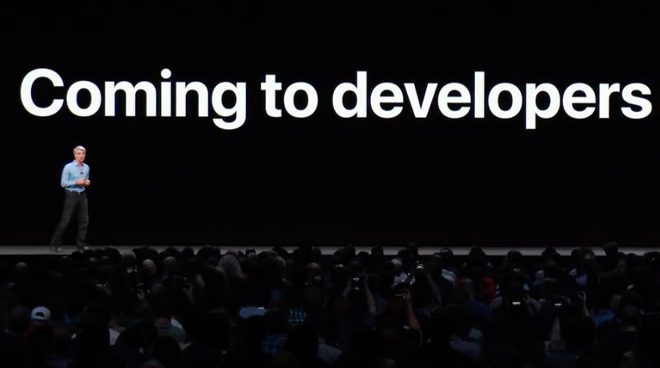
Apple says Catalyst is a multi-year project.
You're not going to see your favorite iOS apps come to the Mac this month. Despite Apple's creation and championing of what it called its Mac Catalyst service for converting apps, you're not likely to see them this year, either. Apple was very clear that this is a multi-year process.
Plus, while it's been one year for Apple, it's been only a few months for developers. Perhaps it's not surprising that more people are complaining to AppleInsider about Catalyst than are praising it.
Yet there is praise, there is hope, and there are apps coming.
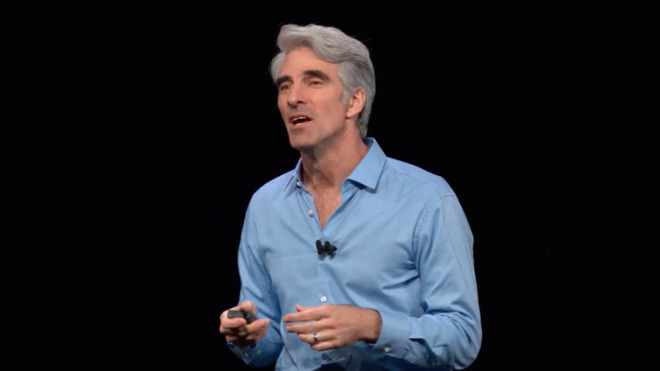
Craig Federighi introducing the topic of Catalyst at WWDC 2018
And the addition of the Mac market to any iOS app may well be the element that makes developing for these platforms attractive to entirely new people. Apple claims that Catalyst is going to get us all more Mac apps, and even also improve iPad ones.
In the meantime, though, we spoke with large and small developers, and we spoke on and off the record with people working to bring iOS apps to the Mac.
For others, though, Catalyst is the reason they began considering making a Mac version -- even if some developers soon decided to stop, and others are choosing to postpone the work until they've exploited all the new benefits in iOS 13 and iPad OS 13.
"Catalyst came at a funny time for us," says Jake Underwood from Moleskine Digital Studio, maker of Timepage calendar app and Actions to do software. "We are extremely excited. We were always asked by our users, when is [a Mac version] coming, and we never felt that we had the right solution to do it."
"The way Apple revealed it was that it's checking a box," says Underwood. "And in a lot of ways that's true. After the WWDC 2019 keynote, [the team] went back to our Airbnb, checked that box and just saw what happened."
"That check the box thing solves the barrier to entry in a really powerful way," he continues, "and there are apps that might just do that. But for us, we want to craft the perfect Timepage or Actions experience on the desktop. We've got to say, okay, what are some Mac philosophies that we want to adhere to?"
So there's much more work to be done before a developer such as Moleskine can publicly commit to launching a Mac version. It looks like there is also a lot more work to be done before Apple can really do much of the same, even as it has these existing examples.
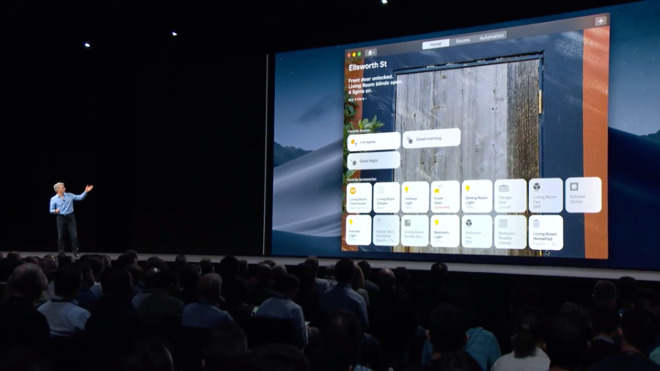
That's the first view we had of the iOS Home app now running on a Mac
"Despite that public pronouncement," he continues, "the apps have not seen major changes since the first Catalina beta, and seem on track to ship in a less-than-excellent state for another year. If Apple can't make really great Mac apps using Catalyst, what hope do third-party developers have?"
The Home app on the Mac, for instance, can control all of your HomeKit devices, such as smart bulbs, but to add a new one, you still have to launch the original iOS version.
That iOS Home app has its own critics, and enough so that there are third-party alternatives to it such as Home 3 by Matthias Hochgatterer.
However, Hochgatterer says he won't be bringing Home 3 to the Mac, though that's at least in part because HomeKit on the Mac is not quite what it seems. While there is now a Home app and it can control any HomeKit devices you may have, Apple officially tells developers that HomeKit is not on the Mac.
"HealthKit and HomeKit are not available at this point since not all of the underlying functionality is present," said Jason Beaver, Senior Engineering Manager and Architect, iOS Apps & Framework, in a WWDC 2019 developer video called "Introducing iPad Apps for Mac".
"In my case, I can't use it anyway, because HomeKit is not available on the Mac," says Hochgatterer. "[But Catalyst] is not designed to make good Mac apps. It's designed to extend the reach of iOS apps to Mac users. There might be some exceptions, but I don't think we will see any good Catalyst apps."
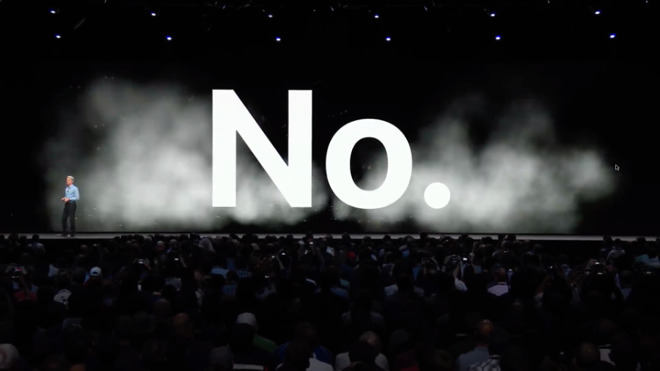
Craig Federighi's blink-and-you'll-miss it hint about whether the Mac and iOS are merging
"[Because] Catalyst is quite buggy, horribly under-documented and misses example projects," said Steinberger. "When we hit a weird behavior, we don't even know if this is a bug or if it's supposed to be like this."
Steinberger talks at conferences about Catalyst and despite his criticism of its current state, does believe it will become useful, if developers add in some Mac-specific programming.
"There are a few pieces missing to make [Catalyst create] a great Mac app, but these can be filled using [the macOS] AppKit more," Steinberger told us. "There's not even an official statement by Apple if this is allowed at all, but birdies told me that it'll be okay, for now."
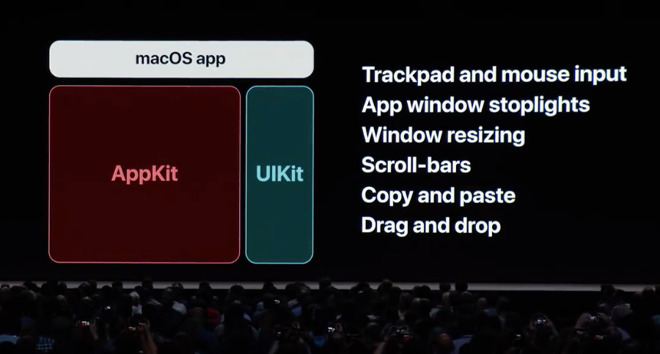
It was probably harder to bring iOS's UIKit to the Mac than this makes it look.
Madsen believes that if Catalyst can get Mac users apps they don't already have, then it's exciting.
"My personal feeling about whether Catalyst is worth pursuing is that it's probably most worth it for developers with relatively simple apps," he says, "especially those focused on content consumption, where the expense and time required to write an AppKit app wouldn't make business sense."
"I think the intersection between Mac users and iOS users makes up such a large percentage of users that it's not likely to open up major new audiences for iOS devs," he continues. "Rather, it will likely make their current offerings more attractive because people can use them across both their Macs and their iOS devices."
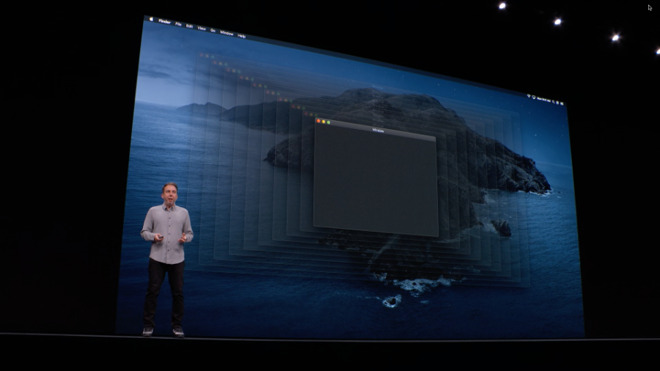
Mike Stern, Platform Experience and Design Evangelism Manager. telling developers how Catalyst works with the Mac's resizable windows
"Catalyst is a pragmatic solution for existing projects," he says. "Catalyst will absolutely not attract new developers to the Apple platform."
He believes that if a developer wants to create a new app, rather than converting one, then Apple's new SwiftUI is the better option, although also a buggy one.
Paul Kafasis from Rogue Amoeba also thinks SwiftUI is the best route for new app developers.
"While Catalyst is a bridge to the future for existing iPad apps," he says. "SwiftUI is the way to make new multi-platform apps. That said, SwiftUI is also quite immature at this time. Time will tell just how useful it becomes. It's certainly interesting, and we'll be keeping an eye on it."
There's no mention of the word 'iPhone' in Apple's developer documentation for this. Mind you, there is also not one single mention of the word 'Catalyst' in the developer session videos from with 2018 or 2019's WWDC, for instance. Instead, Apple always refers to this project as "iPad Apps for Mac," in every relevant session title, in every transcript of every video.
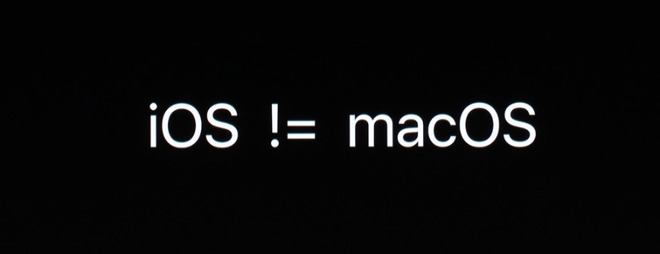
Detail of a slide from Apple's developer sessions about converting iOS apps to the Mac
One developer, speaking to AppleInsider off the record, said that Catalyst was "certainly useful," but wouldn't be any use to them since their app is solely an iPhone one.
"[Our app] is not yet adapted to the iPad natively, so this [would] be the first step," they said. "Being able to also address the Mac as a platform will certainly increase the priority of this undertaking, but we're currently fully focused on the next major version for iPhone."
This developer's app is particularly suited to the iPhone, and it has consistently won awards over the decade since it was launched. They told us that having an iPad or a Mac version is appealing because it would help users plan out their journeys more. However, Catalyst requiring an iPad version to start from, means this is a far more involved job than checking a box.
Other developers agree.
"The iPhone/iPad separation is weird to me," says Peter Steinberger. "Catalyst is UIKit for the Mac. Any good app can deal with different screen sizes -- that's something you need on iPad already. But even a more widget-like app that just has a fixed form factor could be useful on the Mac (think: weather widget for the menu bar)."
"And there's really no technical limitation to build exactly that," he continues, "other than menu bar access again needing AppKit code, as Catalyst doesn't offer API for this."
"I also think that Catalyst is competing against web-based cross-platform app development technologies like Electron as much as it's competing against AppKit," says Madsen. "As someone who has never been particularly impressed by the user experience provided by Electron, I'm hopeful that Catalyst provides an attractive alternative to developers compared to Electron."
"If the choice is between an Electron app or a Catalyst app," he continues, "I think the Catalyst app is much more likely to provide the better experience."
Madsen also raises the point that even if adding a Mac app really were a case of checking one box in Xcode, there is still the issue of distributing, selling and supporting the new app. Developers on iOS are used to the App Store, where Apple handles the distribution and the fees, whereas Mac firms can have their own store. That brings benefits but also problems and an extra overhead to maintain.
"For that reason, I think most Catalyst developers will and should opt for distributing only via the Mac App Store," says Madsen, "despite Apple not requiring this. Otherwise, iOS developers will find themselves needing to do a lot of additional work to set up an online store, licensing, automatic updates, etc. This is doubly difficult for those that use a subscription business model."
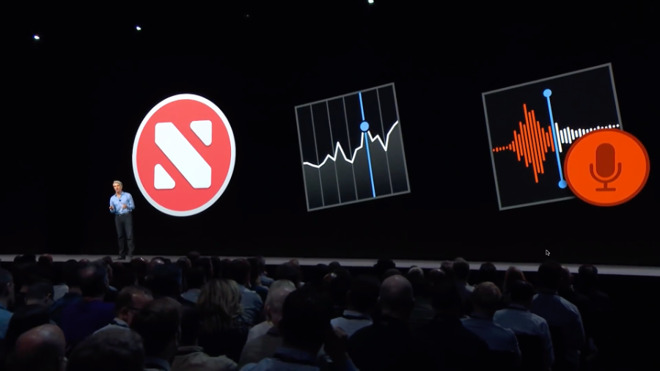
Some of Apple's own iOS apps brought to the Mac
The advantage of Catalyst is meant to be in how it removes barriers to iOS developers coming to the Mac. And if there are problems now, and there may be difficulties getting distribution right, it is at least beginning to work.
For instance, Chris Demiris, co-founder and head of development at Luma Touch, is quite up front about how the company's plans have changed because of Catalyst.
The firm makes LumaFusion, a highly successful video-editing app for iOS, and they now intend to bring it to the Mac.
"We have had our runtime engine and model running on macOS for some time, and have planned to port to macOS," says Demiris, "but the sheer amount of work for the UI was what held us back. Catalyst could give us a quick head start there, but I still think we'd need a lot of work to make the app a 'useful' Mac app that feels right."
"We feel it would have a good fit in between iMovie and Final Cut Pro X," he continues. "We will likely put in some effort on this after a few more important feature releases are finished on iOS."
Right now, Catalyst is only one of very many new functions and facilities that Apple is providing developers with macOS Catalina, iOS 13 and iPad OS 13.
"When my team left WWDC 2019, we were saying that the week had brought something for everyone," says Moleskine's Jake Underwood. "Then you sit down and want to start building with Catalyst, but you realize there is just so much going on. I think the best developers, they'll step back and say they want to make this product be the best it can be, rather than be first to ship it [alongside macOS Catalina]."
Every developer we spoke to said they were focused on at least making their app compatible with these new releases, and most were working to leverage Apple's new functionality.
An iOS developer's focus is, of course, always going to be on their iOS app before anything else. However, Catalyst is here, and if it's currently far from being fully baked, it could get there -- just not by September 10.
Keep up with AppleInsider by downloading the AppleInsider app for iOS, and follow us on YouTube, Twitter @appleinsider and Facebook for live, late-breaking coverage. You can also check out our official Instagram account for exclusive photos.

Apple says Catalyst is a multi-year project.
You're not going to see your favorite iOS apps come to the Mac this month. Despite Apple's creation and championing of what it called its Mac Catalyst service for converting apps, you're not likely to see them this year, either. Apple was very clear that this is a multi-year process.
Plus, while it's been one year for Apple, it's been only a few months for developers. Perhaps it's not surprising that more people are complaining to AppleInsider about Catalyst than are praising it.
Yet there is praise, there is hope, and there are apps coming.

Craig Federighi introducing the topic of Catalyst at WWDC 2018
And the addition of the Mac market to any iOS app may well be the element that makes developing for these platforms attractive to entirely new people. Apple claims that Catalyst is going to get us all more Mac apps, and even also improve iPad ones.
In the meantime, though, we spoke with large and small developers, and we spoke on and off the record with people working to bring iOS apps to the Mac.
Horse's mouth
Every single developer we approached, across iOS and Mac, has seriously looked at Catalyst. A surprisingly high proportion simply have no use for it, because they've already got Mac apps in development.For others, though, Catalyst is the reason they began considering making a Mac version -- even if some developers soon decided to stop, and others are choosing to postpone the work until they've exploited all the new benefits in iOS 13 and iPad OS 13.
"Catalyst came at a funny time for us," says Jake Underwood from Moleskine Digital Studio, maker of Timepage calendar app and Actions to do software. "We are extremely excited. We were always asked by our users, when is [a Mac version] coming, and we never felt that we had the right solution to do it."
What Catalyst offers
Catalyst is a way that iOS developers can simply select one extra option within Apple's Xcode and have a Mac app generated automatically. By way of example, in 2018, Apple released macOS versions of its own News, Stocks, Home and Voice Memos apps."The way Apple revealed it was that it's checking a box," says Underwood. "And in a lot of ways that's true. After the WWDC 2019 keynote, [the team] went back to our Airbnb, checked that box and just saw what happened."
"That check the box thing solves the barrier to entry in a really powerful way," he continues, "and there are apps that might just do that. But for us, we want to craft the perfect Timepage or Actions experience on the desktop. We've got to say, okay, what are some Mac philosophies that we want to adhere to?"
So there's much more work to be done before a developer such as Moleskine can publicly commit to launching a Mac version. It looks like there is also a lot more work to be done before Apple can really do much of the same, even as it has these existing examples.
Apple's Catalyst apps
"Their quality varies," says Andrew Madsen, Mac and iOS developer, "but none of them could be called a great Mac app. Apple has made some public commentary to assuage concerns around these apps, going so far as to say that they'd be majorly improved in the first public beta of Catalina."
That's the first view we had of the iOS Home app now running on a Mac
"Despite that public pronouncement," he continues, "the apps have not seen major changes since the first Catalina beta, and seem on track to ship in a less-than-excellent state for another year. If Apple can't make really great Mac apps using Catalyst, what hope do third-party developers have?"
The Home app on the Mac, for instance, can control all of your HomeKit devices, such as smart bulbs, but to add a new one, you still have to launch the original iOS version.
That iOS Home app has its own critics, and enough so that there are third-party alternatives to it such as Home 3 by Matthias Hochgatterer.
However, Hochgatterer says he won't be bringing Home 3 to the Mac, though that's at least in part because HomeKit on the Mac is not quite what it seems. While there is now a Home app and it can control any HomeKit devices you may have, Apple officially tells developers that HomeKit is not on the Mac.
"HealthKit and HomeKit are not available at this point since not all of the underlying functionality is present," said Jason Beaver, Senior Engineering Manager and Architect, iOS Apps & Framework, in a WWDC 2019 developer video called "Introducing iPad Apps for Mac".
"In my case, I can't use it anyway, because HomeKit is not available on the Mac," says Hochgatterer. "[But Catalyst] is not designed to make good Mac apps. It's designed to extend the reach of iOS apps to Mac users. There might be some exceptions, but I don't think we will see any good Catalyst apps."

Craig Federighi's blink-and-you'll-miss it hint about whether the Mac and iOS are merging
Buggy
Peter Steinberger, CEO and Founder of PSPDFKit, agrees. He thinks there will be a lot of simple apps, and "bad ports of bad iOS apps," but few or no great ones -- at least at first."[Because] Catalyst is quite buggy, horribly under-documented and misses example projects," said Steinberger. "When we hit a weird behavior, we don't even know if this is a bug or if it's supposed to be like this."
Steinberger talks at conferences about Catalyst and despite his criticism of its current state, does believe it will become useful, if developers add in some Mac-specific programming.
"There are a few pieces missing to make [Catalyst create] a great Mac app, but these can be filled using [the macOS] AppKit more," Steinberger told us. "There's not even an official statement by Apple if this is allowed at all, but birdies told me that it'll be okay, for now."

It was probably harder to bring iOS's UIKit to the Mac than this makes it look.
Madsen believes that if Catalyst can get Mac users apps they don't already have, then it's exciting.
"My personal feeling about whether Catalyst is worth pursuing is that it's probably most worth it for developers with relatively simple apps," he says, "especially those focused on content consumption, where the expense and time required to write an AppKit app wouldn't make business sense."
"I think the intersection between Mac users and iOS users makes up such a large percentage of users that it's not likely to open up major new audiences for iOS devs," he continues. "Rather, it will likely make their current offerings more attractive because people can use them across both their Macs and their iOS devices."
Workarounds and the future
Steinberger worries that workarounds to add necessary AppKit functions to Catalyst apps won't be supported and may be broken by future Apple releases. He points out, for example, that Catalyst doesn't yet allow a developer to change how your mouse cursor looks, for instance to indicate when you're hovering over a link or a button.
Mike Stern, Platform Experience and Design Evangelism Manager. telling developers how Catalyst works with the Mac's resizable windows
"Catalyst is a pragmatic solution for existing projects," he says. "Catalyst will absolutely not attract new developers to the Apple platform."
He believes that if a developer wants to create a new app, rather than converting one, then Apple's new SwiftUI is the better option, although also a buggy one.
Paul Kafasis from Rogue Amoeba also thinks SwiftUI is the best route for new app developers.
"While Catalyst is a bridge to the future for existing iPad apps," he says. "SwiftUI is the way to make new multi-platform apps. That said, SwiftUI is also quite immature at this time. Time will tell just how useful it becomes. It's certainly interesting, and we'll be keeping an eye on it."
Bring iPad apps to the Mac
Kafasis was quite correct to specify "iPad apps." While the reasonable public perception of Catalyst may be that it will bring people's favorite iPhone apps to the Mac, it won't.There's no mention of the word 'iPhone' in Apple's developer documentation for this. Mind you, there is also not one single mention of the word 'Catalyst' in the developer session videos from with 2018 or 2019's WWDC, for instance. Instead, Apple always refers to this project as "iPad Apps for Mac," in every relevant session title, in every transcript of every video.

Detail of a slide from Apple's developer sessions about converting iOS apps to the Mac
One developer, speaking to AppleInsider off the record, said that Catalyst was "certainly useful," but wouldn't be any use to them since their app is solely an iPhone one.
"[Our app] is not yet adapted to the iPad natively, so this [would] be the first step," they said. "Being able to also address the Mac as a platform will certainly increase the priority of this undertaking, but we're currently fully focused on the next major version for iPhone."
This developer's app is particularly suited to the iPhone, and it has consistently won awards over the decade since it was launched. They told us that having an iPad or a Mac version is appealing because it would help users plan out their journeys more. However, Catalyst requiring an iPad version to start from, means this is a far more involved job than checking a box.
Other developers agree.
"The iPhone/iPad separation is weird to me," says Peter Steinberger. "Catalyst is UIKit for the Mac. Any good app can deal with different screen sizes -- that's something you need on iPad already. But even a more widget-like app that just has a fixed form factor could be useful on the Mac (think: weather widget for the menu bar)."
"And there's really no technical limitation to build exactly that," he continues, "other than menu bar access again needing AppKit code, as Catalyst doesn't offer API for this."
Other solutions and practical problems
It's not as if Catalyst is the only route for iOS developers to take, either."I also think that Catalyst is competing against web-based cross-platform app development technologies like Electron as much as it's competing against AppKit," says Madsen. "As someone who has never been particularly impressed by the user experience provided by Electron, I'm hopeful that Catalyst provides an attractive alternative to developers compared to Electron."
"If the choice is between an Electron app or a Catalyst app," he continues, "I think the Catalyst app is much more likely to provide the better experience."
Madsen also raises the point that even if adding a Mac app really were a case of checking one box in Xcode, there is still the issue of distributing, selling and supporting the new app. Developers on iOS are used to the App Store, where Apple handles the distribution and the fees, whereas Mac firms can have their own store. That brings benefits but also problems and an extra overhead to maintain.
"For that reason, I think most Catalyst developers will and should opt for distributing only via the Mac App Store," says Madsen, "despite Apple not requiring this. Otherwise, iOS developers will find themselves needing to do a lot of additional work to set up an online store, licensing, automatic updates, etc. This is doubly difficult for those that use a subscription business model."

Some of Apple's own iOS apps brought to the Mac
The advantage of Catalyst is meant to be in how it removes barriers to iOS developers coming to the Mac. And if there are problems now, and there may be difficulties getting distribution right, it is at least beginning to work.
For instance, Chris Demiris, co-founder and head of development at Luma Touch, is quite up front about how the company's plans have changed because of Catalyst.
The firm makes LumaFusion, a highly successful video-editing app for iOS, and they now intend to bring it to the Mac.
"We have had our runtime engine and model running on macOS for some time, and have planned to port to macOS," says Demiris, "but the sheer amount of work for the UI was what held us back. Catalyst could give us a quick head start there, but I still think we'd need a lot of work to make the app a 'useful' Mac app that feels right."
"We feel it would have a good fit in between iMovie and Final Cut Pro X," he continues. "We will likely put in some effort on this after a few more important feature releases are finished on iOS."
Forthcoming iOS updates
That is another issue that is going to guarantee we won't see native Mac versions of great iPad apps at the September 10 event. And it's a reason why no developer, including Luma Touch, will or even can commit to when their apps may come to the Mac.Right now, Catalyst is only one of very many new functions and facilities that Apple is providing developers with macOS Catalina, iOS 13 and iPad OS 13.
"When my team left WWDC 2019, we were saying that the week had brought something for everyone," says Moleskine's Jake Underwood. "Then you sit down and want to start building with Catalyst, but you realize there is just so much going on. I think the best developers, they'll step back and say they want to make this product be the best it can be, rather than be first to ship it [alongside macOS Catalina]."
Every developer we spoke to said they were focused on at least making their app compatible with these new releases, and most were working to leverage Apple's new functionality.
An iOS developer's focus is, of course, always going to be on their iOS app before anything else. However, Catalyst is here, and if it's currently far from being fully baked, it could get there -- just not by September 10.
Keep up with AppleInsider by downloading the AppleInsider app for iOS, and follow us on YouTube, Twitter @appleinsider and Facebook for live, late-breaking coverage. You can also check out our official Instagram account for exclusive photos.


Comments
not offtopic
So much new stuff and only a few months to implement something. It’s no surprise that only a minority decided to use the precious limited time to make a Mac app.
Of course the one major company who creates iOS apps and is ok only having Mac versions of those apps on the desktop is Apple itself. So presumably we'll see more investment in this technology. But I doubt it will be much more than a curiosity in a practical sense.
It seems obvious that “just checking a box” is B.S. for most developers, if they want to give their users a quality experience.
For many devs it might be better to develop web apps that work anywhere....
My own experience was when a group of programmers wrote programs to convert ATM management software from a Tandem computer to an IBM. When companies changed hands they were let go and it was dumped on me. It was a nightmare... 99% of the code worked 99% percent of the time -- but there was so much code the thing blew up almost daily.
While this is different from fine tuning the user experience to the hardware being used, it was just another example of an automated port of an application. It saves time and money but seldom produces an optimal result.
“We’ve done tons of user testing on this, and it turns out it doesn’t work. Touch surfaces don’t want to be vertical.
It gives great demo but after a short period of time, you start to fatigue and after an extended period of time, your arm wants to fall off. it doesn’t work, it’s ergonomically terrible.
Touch surfaces want to be horizontal, hence pads.
For a notebook, that’s why we’re perfected our multitouch trackpads over the years, because that’s the best way we’ve found to get multitouch into a notebook.
We’ve also, in essence, put a trackpad — a multitouch track pad on the mouse with our magic mouse. And we’ve recently come out with a pure play trackpad as well for our desktop users.
So this is how we're going to use multitouch on our Mac products because this (he points at someone touch laptop screen) doesn’t work.”
I have a massive vertical touch screen at work (you stand in front of it) and it is fine in regard to fatigue. I can well understand though, if you have an iMac on your desk then having to abnormally bend the wrist for a touch screen would result in fatigue in a very short time.